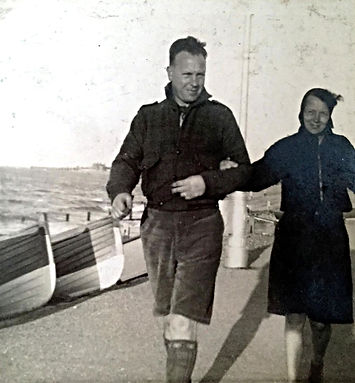ALBERT'S STORY
Albert was born in Bethnal Green in London’s East End in 1900. It was a time and a place defined by poverty and hardship but also by strong community. After leaving school at fourteen Albert joined the army in 1915 and transferred shortly afterwards to the Royal Marines.
It was on ship that Albert fell in love with painting. Returning home from war he fell in love again - with Sarah “Sally” Fellows. Albert and Sally married at St John’s Church in Bethnal Green in 1922. It was to be a life-long love affair and Albert lovingly immortalised Sarah in many of his sketches and paintings.
Shortly after his wedding Albert took up window cleaning to earn a crust. But having not forgotten his love of art, Albert would ensure he had finished his cleaning rounds by lunchtime so he could spend the rest of the day painting.
"Why give a man a fifteen stone body, the temper of the story-type Irish navvy, with the face of a fighting pug, and then implant a tiny seed of melancholy, a tiny seed but enough to bring tears when an old piece of music is played or a poem read"
From Albert's memoirs


To help improve his painting technique, Albert signed up for evening classes at Bethnal Green Working Men’s Institute and at the Bow & Bromley Commercial Institute. Among Albert’s teachers in Bethnal Green was John Cooper, whose classes at Bow led to the formation of the East London Group of artists, which included George Board, Archibald Hattemore, Elwin Hawthorne and Harold and Walter Steggles.
It was on his way to an art group in 1926, the year of the General Strike, that Albert heard a speech by Bill Gee that was to change the course of his life: He immediately joined the Labour Party and became a prominent activist for workers' rights and an anti-fascist. He later served as a Labour Councillor and was unanimously elected Mayor of Bethnal Green in 1946. He refused to wear mayoral robes, the Evening News reported, “because he thinks it is a waste of taxpayers’ money.”


Albert had joined the National Fire Service in 1941 and served with them throughout World War II, having served part-time with the London Fire Brigade from early 1938. From 1940 he was an official Fire Brigade War Artist with his work exhibited both in Britain and North America.
Albert died in 1964 leaving his wife Sally and two adult children Bill and Joan. His work was exhibited during his lifetime at the Lefevre Gallery, Guildhall Art Gallery, Whitechapel Art Gallery, the Royal Academy, Tate Gallery and abroad. Together with other artists of the East London Group, Turpin’s work has recently been exhibited at Bloomsbury and Bow Arts.
Albert Edward Turpin was an extraordinary man; someone of great principle and incredible artistic talent. He made a huge difference within his community during his lifetime and leaves behind a huge legacy. His family have created this website to share some of the that legacy more widely.
Read thoughts from Albert's daughter Joan here. A more detailed biography of Albert and other members can be found in David Buckman’s book “From Bow To Biennale: Artists of the East London Group.


